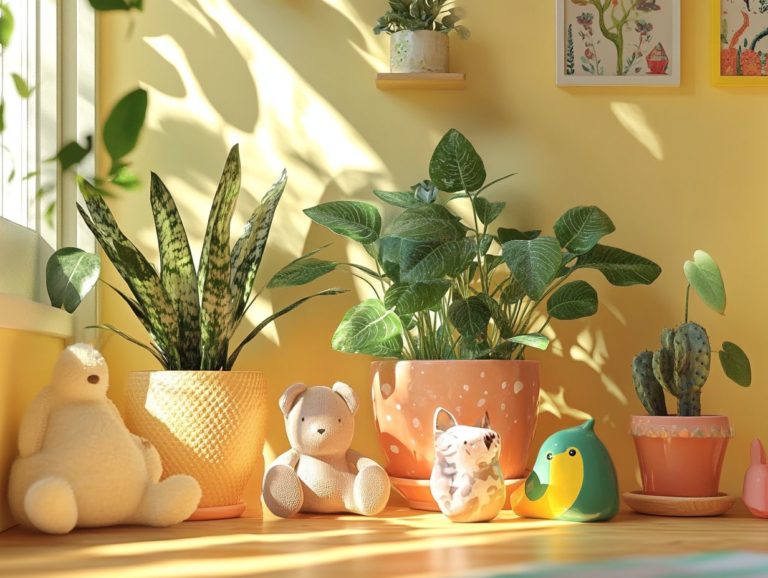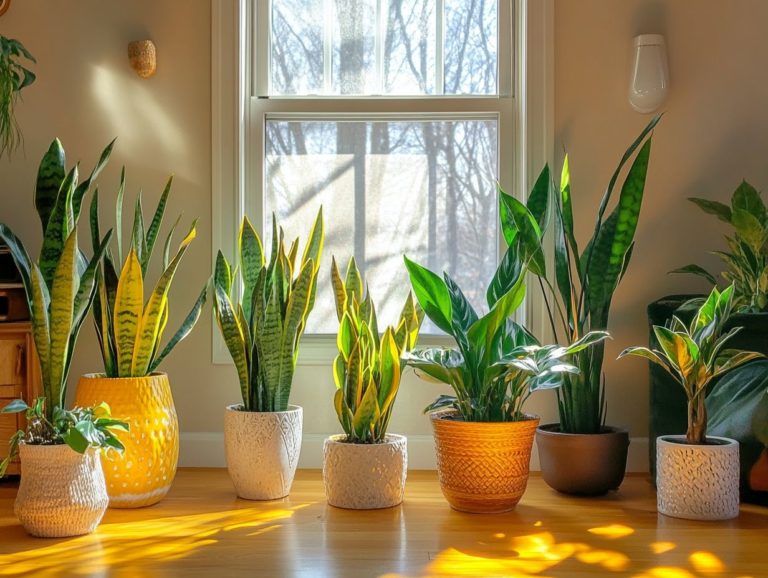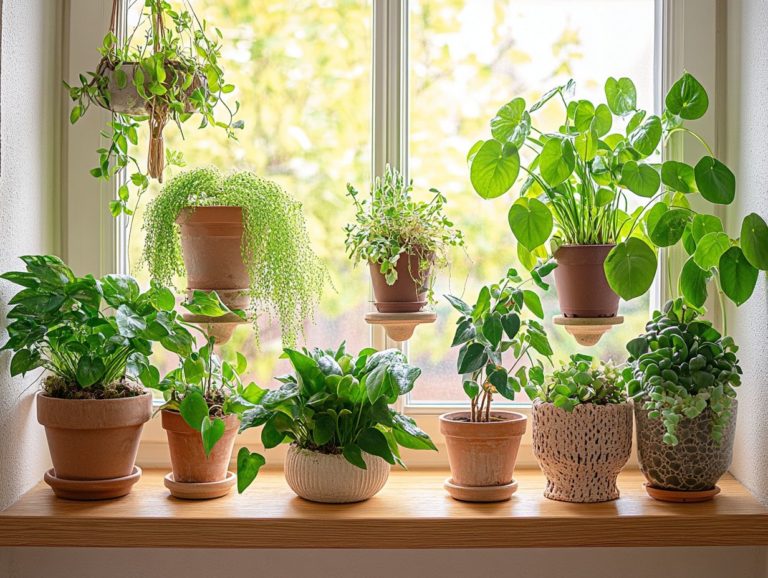5 Low-Light Indoor Plants for Dark Rooms
Are you eager to infuse your home with some greenery but concerned about low-light conditions? You’ve come to the right place!
This article explores five resilient indoor plants that thrive in dim environments, including the Snake Plant and ZZ Plant. You ll discover the benefits these plants offer, essential care tips, and how they can significantly enhance your air quality while being long-lasting companions.
You will find various low-light options that brighten those shadowy corners of your home.
Get ready to transform your space and bring the beauty of nature indoors!
Contents
- Key Takeaways:
- 1. Snake Plant
- 2. ZZ Plant
- 3. Peace Lily
- 4. Chinese Evergreen
- 5. Cast Iron Plant
- What Are the Benefits of Having Indoor Plants?
- Frequently Asked Questions
- What are the best low-light indoor plants for dark rooms?
- How do I know if my room is considered a dark room?
- Are low-light indoor plants suitable for dark rooms with no windows?
- Do low-light indoor plants require a lot of care and maintenance?
- Can I still have a variety of plants in a dark room?
- Can low-light indoor plants purify the air in dark rooms?
Key Takeaways:
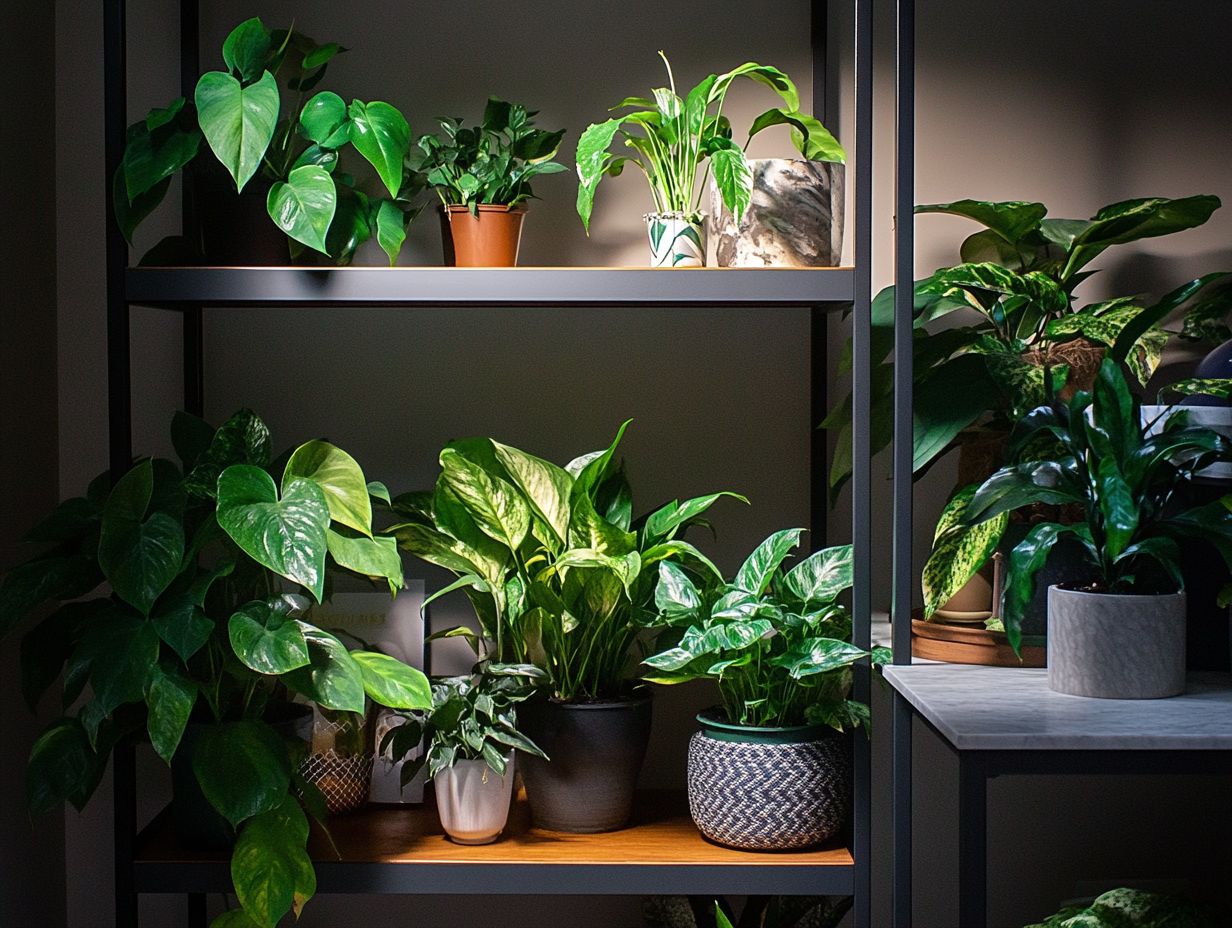
- Low-light indoor plants can thrive in dark rooms and add a touch of nature to your indoor space.
- Top choices for low-light plants include the Boston Fern, Philodendron, ZZ Plant, Pothos, Snake Plant, Peace Lily, Chinese Evergreen, and Cast Iron Plant.
- These plants not only beautify your space but also clean the air and require minimal care.
1. Snake Plant
The Snake Plant, or Sansevieria, is your go-to easy-care indoor plant. It’s celebrated for thriving effortlessly in low-light conditions.
This plant showcases striking sword-like leaves in various colors and patterns, adding visual appeal even in the dimmest corners. Remarkably adaptable, it tolerates fluctuating humidity levels, making it an ideal fit for any home environment.
Beyond its beauty, the Snake Plant actively cleans the air by filtering out toxins, contributing to a healthier living space. However, if you have furry companions, use caution, as the leaves contain mild toxins that could pose a risk if ingested.
2. ZZ Plant
The ZZ Plant, or Zamioculcas zamiifolia, is a remarkably resilient houseplant known for thriving in low-light conditions. With minimal water requirements and lush, attractive foliage, it s perfect for beginners and seasoned indoor gardeners alike.
Its striking glossy leaves can survive in near darkness, making it an excellent choice for rooms with limited natural light. This plant thrives with infrequent watering typically every two to three weeks allowing the soil to dry out between sessions to avoid root rot.
The ZZ Plant is not particularly demanding when it comes to humidity. This adaptability enhances its appeal as a low-maintenance green companion, fitting seamlessly into the busy lifestyles of many plant enthusiasts.
3. Peace Lily
The Peace Lily, or Spathiphyllum, is known for its breathtaking white blooms and exceptional air purification capabilities. It thrives in humid environments and is perfect for anyone seeking low-light indoor plants that offer striking foliage.
To keep this beautiful plant flourishing, ensure it receives indirect sunlight, as direct rays can scorch its delicate leaves. Water it when the top inch of soil feels dry, aiming for consistently moist soil without letting it become soggy.
Since Peace Lilies flourish in higher humidity levels, consider misting the leaves or using a humidifier nearby to encourage lush growth. With the right care, this exquisite plant enhances air quality and elevates the aesthetics of any indoor space, infusing it with a sense of tranquility and vibrancy.
4. Chinese Evergreen

The Chinese Evergreen, or Aglaonema, is your go-to indoor plant if you’re seeking something that requires minimal effort yet delivers maximum aesthetic appeal. With its stunning array of leaves, this plant thrives in both bright indirect light and low-light environments, making it incredibly versatile.
Picture this: variegated leaves displaying shades of green, silver, or even a touch of red this plant adds a striking visual element to any room. Its diverse varieties, from the deep green ‘Emerald Beauty’ to the eye-catching ‘Red Peacock’, each bring their own unique splash of color to your indoor spaces.
If you’re interested in propagating your Chinese Evergreen or other suitable varieties, you can easily do so with stem cuttings or through division during repotting. Ensure you have proper drainage and suitable soil to avoid root rot. Be cautious with watering; overwatering is a common pitfall. A sprinkle of fertilizer during the growing season will encourage lush foliage and vibrant growth.
Consider adding this beautiful plant to your home today!
5. Cast Iron Plant
The Cast Iron Plant, or Aspidistra elatior, is the perfect companion for your indoor space, offering hardy resilience against low-light conditions and neglect. If you’re looking for low-maintenance greenery that thrives in various environments, this plant fits the bill beautifully.
This remarkable specimen not only endures fluctuating humidity levels but also flourishes in dim corners where other plants might wither. With its broad, dark green leaves, it adds a touch of elegance to any room that doesn t bask in direct sunlight.
Caring for this resilient species is refreshingly simple: just water infrequently, ensuring well-drained soil. Allow the soil to dry out partially between sessions, and give the leaves an occasional dusting to keep them in tip-top shape.
If you want to grow your collection, propagation is easy with methods like cuttings and division just divide the rhizomes during repotting. Keep in mind, though, that while the Cast Iron Plant is generally safe, its leaves can be mildly toxic if ingested by pets, so it s wise to be cautious.
Consider including this resilient plant in your collection!
What Are the Benefits of Having Indoor Plants?
Having indoor plants does more than just make your space look better; it brings a myriad of environmental benefits that can significantly enhance your quality of life. These vibrant green companions work tirelessly to purify the air, increase humidity levels, and boost your overall well-being.
They absorb harmful toxins, transforming your indoor air into a refreshing atmosphere, which creates a healthier space perfect for relaxation and productivity. As they transpire moisture, indoor plants raise humidity levels, helping to combat dryness and alleviate respiratory issues and skin irritations.
Low-light varieties, like snake plants and pothos, thrive in dim conditions and effortlessly promote tranquility, positively affecting your mood and mental clarity. In essence, these plants serve as a natural remedy for the stresses of daily life, cultivating a serene and revitalizing environment that you can enjoy every day.
Consider adding indoor plants to your home for a healthier lifestyle!
What Are the Factors to Consider When Choosing Low-Light Indoor Plants?
When selecting low-light indoor plants, it s crucial to consider factors such as light conditions, humidity levels, and soil type. These elements are essential for optimal growth. This approach ensures healthy growth and makes maintenance easier.
Understanding the nuances of light intensity and how bright colors reflect in the leaves can significantly influence your plants vitality. Inadequate lighting may stunt growth or lead to disease, so it s worth paying attention to. Humidity is also crucial; many indoor plants thrive with increased moisture in the air, which is vital in dry indoor climates.
Choosing the right soil is equally important, as it ensures that roots receive adequate nutrition and proper drainage. For example, the Snake Plant and ZZ Plant are excellent choices for low-light conditions; they reduce the risk of overwatering and adapt well to varying humidity levels.
By tailoring your selection based on these considerations, you not only promote plant health but also create a lush, vibrant ambiance in your indoor spaces.
How Do These Plants Survive in Low-Light Environments?

Low-light indoor plants have developed fascinating adaptations that make them perfectly suited for those dim corners of your home. With broad leaves and slow growth rates, they thrive in indirect light and manage to survive where sunlight is scarce.
These smart adaptations help them thrive, even on the darkest days. Their lower water requirements mean they can withstand periods of drought, thanks to deeper root systems that efficiently absorb moisture from the soil.
Due to these conditions, their growth patterns often lead to a more compact structure, helping them conserve energy and resources. Many of these plants prefer propagation methods like division or cuttings rather than relying on seed dispersal, as their environments tend to be stable, fostering resilience in various indoor settings.
What Are the Care and Maintenance Tips for These Plants?
To ensure the longevity and health of your low-light indoor plants, proper care and maintenance are crucial. You’ll want to understand their specific water needs, suitable soil types, and the ideal humidity levels for thriving growth.
These plants often hail from tropical regions, which shapes their care requirements. For instance, many flourish in soil that retains moisture while still allowing for good drainage. A blend of potting soil (a mix designed for potted plants) with perlite or orchid bark is a wise choice. Water when the top inch of soil feels dry to prevent root rot.
Maintaining a humidity level between 40-60% is beneficial for humidity-loving plants. You can achieve this by placing trays of water near your plants or misting them occasionally. By tending to these specific needs, you ll support their growth and amplify their decorative appeal in any indoor space.
Can These Plants Help Improve Indoor Air Quality?
Many low-light indoor plants, such as the Peace Lily and ZZ Plant, are your allies in the quest for cleaner air. These remarkable plants excel at purifying the air, filtering out toxins, and enhancing the overall health of your living spaces.
Research from NASA has shown that specific plants, including popular choices like the Boston Fern, can significantly reduce harmful toxins like formaldehyde and benzene. For example, the Spider Plant not only flourishes in low light but also diligently absorbs these hazardous substances. To ensure you care for such plants effectively, consider these 5 tips for watering low-light plants. The Bamboo Palm takes it a step further, known for its ability to humidify the air, helping ease respiratory issues and promoting overall wellness.
Bring these incredible plants into your home today and transform your air quality! By welcoming such greenery into your spaces, you can cultivate a healthier atmosphere filled with vibrant leaves, potentially alleviating headaches, fatigue, and even reducing the risk of chronic illnesses.
What Are Some Other Low-Light Indoor Plant Options?
Along with the Snake Plant and ZZ Plant, you have a wealth of low-light indoor plant options at your fingertips. These include the Boston Fern, Pothos, and Parlor Palm. Each of these plants has unique shapes and vibrant leaves, ready to brighten up your room.
Take the Boston Fern, for example. Its delicate, feathery fronds add a touch of elegance. It thrives in humidity and enjoys regular watering, making it a lovely addition to your collection.
Then there s Pothos, known for its charming heart-shaped leaves that come in eye-catching combinations of green, yellow, and white. This easy-care plant thrives in partial shade or bright indirect light, making it a go-to choice for many settings.
Lastly, the Parlor Palm features graceful arching fronds and a rich green hue, adding a refreshing tropical flair that brightens your space while growing happily in lower light conditions.
These options in your indoor gardening toolkit, including varieties like the Goldfish Plant and Philodendron, will help you cultivate a serene and lush environment. You ll enjoy an array of textures and colors that delight the senses.
Frequently Asked Questions
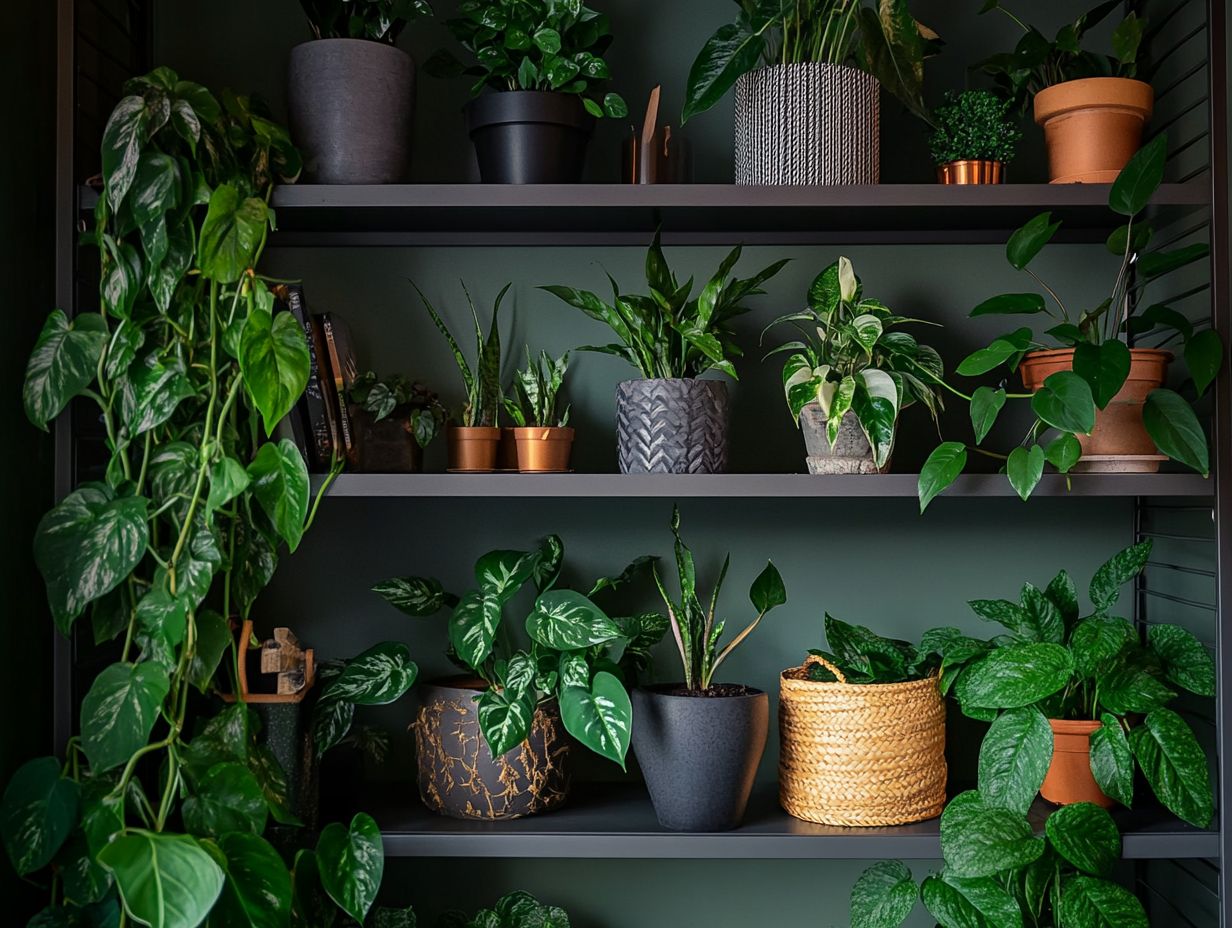
What are the best low-light indoor plants for dark rooms?
Some of the best low-light indoor plants for dark rooms include Snake Plants, Pothos, Peace Lilies, Chinese Evergreens, and ZZ Plants. These are known for their easy care and adaptability.
How do I know if my room is considered a dark room?
A room can be considered dark if it has little to no natural light or very few windows.
Are low-light indoor plants suitable for dark rooms with no windows?
Some low-light indoor plants, such as the ZZ Plant and Cast Iron Plant, can thrive in dark rooms with no windows. However, they may need special lights designed to help plants grow indoors to survive.
Do low-light indoor plants require a lot of care and maintenance?
No, most low-light indoor plants are low-maintenance and require minimal care. However, they still need to be watered and fertilized regularly.
Can I still have a variety of plants in a dark room?
Yes, there are many types of low-light indoor plants that come in different sizes, shapes, and colors. This allows you to create a diverse plant collection in your dark room.
Can low-light indoor plants purify the air in dark rooms?
Yes, low-light indoor plants can help purify the air in dark rooms by absorbing toxins and releasing oxygen through photosynthesis.

